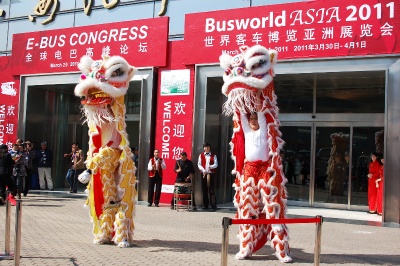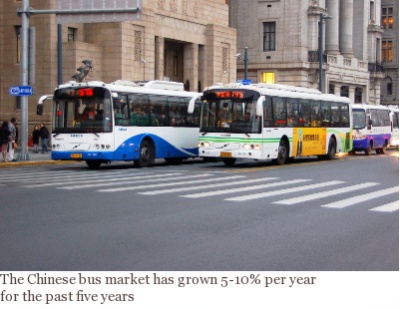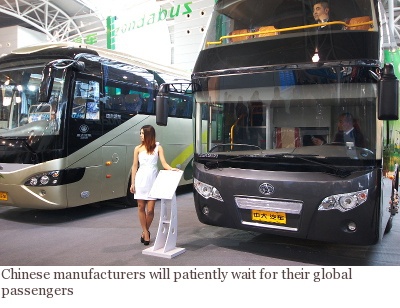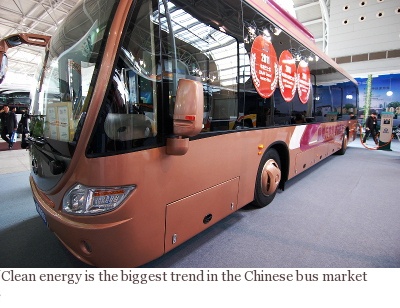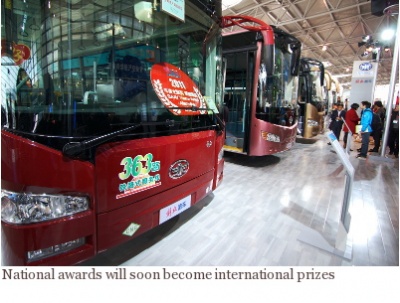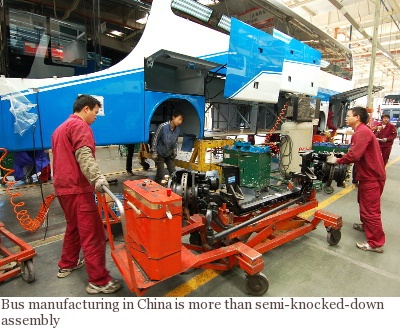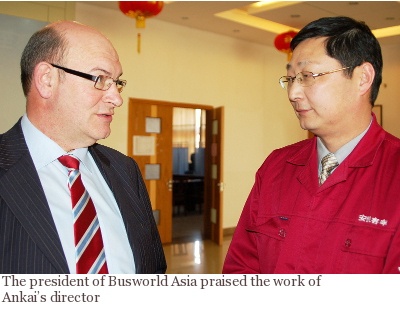 |
|
|
|
A Belgian "nursery" for a Chinese bus
13.04.2011 — Analysis China is urbanizing by leaps and bounds. For example, the population of Beijing has increased by 500,000 people a year for the last decade. As of 2011, 17.55 million people officially live in the Chinese capital, and most of them move around the city quite a bit. Buses, along with bicycles and mopeds, are one of the most important means of transportation for ordinary Chinese. Thus, the government of the Celestial Empire is focusing serious attention on increasing its bus production. The director of "RusBusinessNews", Vadim Dynin, was convinced of this after visiting the BusWorld Asia-2011 exhibit in Shanghai. China takes the first prize at the bus stop Busworld is a well-known brand in the world of automotive manufacturing, and they held their first exhibition of buses in Belgium forty years ago. Busworld Asia also first unveiled its wares back in its Belgian "nursery", in the small town of Kortrijk. Later, of course, it moved them to the Shanghai exhibit, but the Belgians remain Busworld's attentive midwives.
There were 158 participants at this eleventh "Buses Championship", including eight bus-manufacturing factories. One of Busworld Asia 2011's main objectives is to offer a view of the future of manufacturing electric buses. In this context, the E-bus can be viewed as a Chinese industrial strategy - first, talk about the future, then fortify the platform you stand on, and get moving. At first glance, it's hard to differentiate between buses made in China vs. those from Japan, for example. They are well aware in the Celestial Empire that it's not worth the time to experiment with design. Usually they take European products as a starting point, and then localize the production as much as they are able. The Chinese government's stance is the most important part of this process. They bring in foreign experts to find flaws in the production, correct mistakes, and make breakthroughs. Chinese bus factories churn out more than 500 different types of buses every day. Hundreds of thousands of city, tourist, and intercity buses are assembled every year.
What's on the minds of Chinese manufacturers right now? If the topic is energy, that means clean energy with a minimal impact on the environment, which is visible everywhere in this country of a billion inhabitants. If the topic is passenger comfort, then they think it's worth concentrating on installing massage chairs and personal media centers on intercity buses. Manufacturers can't ever slow down, because their rivals are right behind them. Manufacturers compete with each other for the vast domestic market and that's where they try out their new innovations. Exports are gaining momentum, primarily to Southeast Asia and Latin America. Those countries prefer the lower prices and correspondingly lower quality of the Chinese products over European-made buses.
Chinese quality is an issue everywhere in the world. But European experts claim that Chinese-made buses are improving all the time. The president of Busworld Asia, Mark D'Eigens, argues that in many ways their quality is already up to European standards. Of course, the batteries are too big in electric buses. But the Chinese are quick to promise that they will make smaller ones in a year or two. And you can rest assured that they will do it.
Judging from the results of the current exhibit, the Anhui Ankai Automobile Co. and the Chongqing Hengtong Bus Co. lead the pack, while the companies Zhongda and BONLUCK BUS are also worthy of notice. But today's victors could easily be toppled from their pedestal next year by their competitors. The green bus is a big hit on the market The most interesting event that occurred during Asia Coach Week was the visit by a group of European journalists to Ankai's shop floor. Ankai is the third-largest bus company in China, and its production site is located in Hefei. This city of two million is an hour's flight from Shanghai and is one of China's four technology centers. Hefei is not generally considered an industrial city - it is more famous for its gardens and beautiful lake.
Anhui Ankai Automobile Co. began making its way onto the market fifteen years ago, and today they have 3,000 workers producing 10,000 buses a year. This is a good time to take a look at the numbers. European factories make one bus per worker per year, but Chinese plants produce three times that many. Currently, that feverish pace of production is taking a toll on the quality of their products. In Ankai's production facilities, palm trees peacefully coexist with slogans calling for high-quality work and increased production figures. The vast majority of the workforce is between the ages of 18 and 25. It is easy to see that they are still mastering the technology of their jobs. But this is typical everywhere in industrial China.
The Celestial Empire is currently experiencing a period of industrialization similar to that seen in the Soviet Union before WWII. Huge numbers of Chinese have moved from the countryside to the cities to find new employment. They have to learn from scratch how to do their factory jobs. But the difference is that now, in the early 21st century, China has enviable financial resources at its disposal. They are able to bring in experts from abroad to train the modern working class, and the studious Chinese listen to their teachers, spellbound. Plus, the training is carried out using the experience of developed countries as a guide. After only three or four years, Chinese workers possess skills comparable to their counterparts in Europe. Wang Jiangan, the chairman of Ankai's board of directors, claims that investing in new energy-efficient buses is the latest trend in the bus market. This model now makes up 10% of the company's production volume. Hefei is where Ankai tests its energy-efficient buses, and city residents have grown accustomed to the green vehicles.
According to one senior manager, China has increased its production of buses 5-10% per year for the past five years. But the number of manufacturers will decrease in the near future. Ankai intends to strengthen its position in the market. The company is building a new production facility and is taking aim at foreign markets. In addition to its exports to the US, Australia, and the UAE, Ankai is looking hungrily toward Asia, Africa, and Russia. The main problem is not sales, but after-sales service. Once Chinese companies like Ankai manage to build a network of dealers, they will truly become formidable competitors. A Chinese-made bus is headed for your house. |
| Regions | Project participants | Investment projects | Consulates and Trade Offices | News and Analysis | About the Project |
|
© RusBusinessNews, 2009. All rights reserved. Establishing a hyperlink to RIA RusBusinessNews is required for using any of the material published on this website. News and analytical reviews are translated into foreign languages by the TRANSLIT Translation Agency |
«Sum of technologies»® Web design Site promotion |
